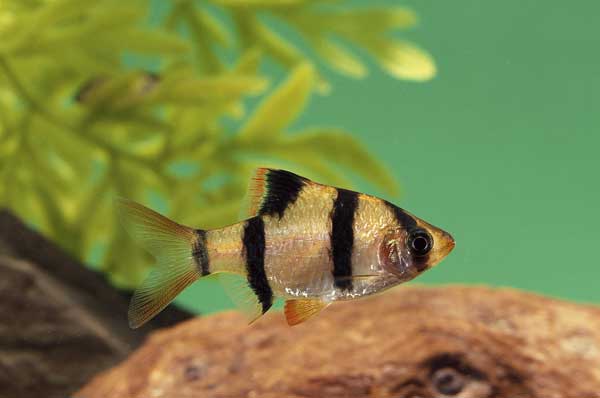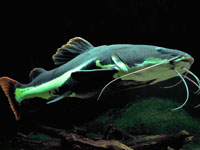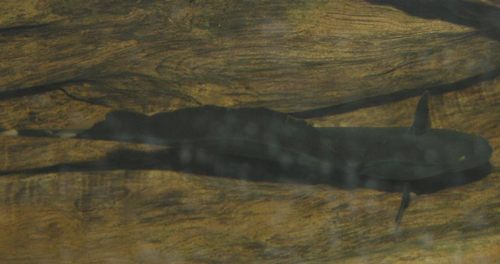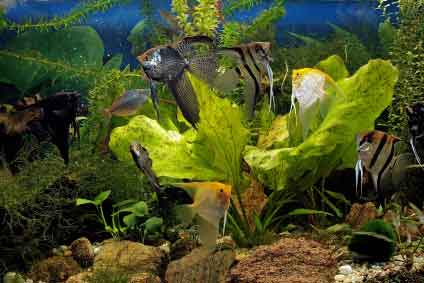
Use ammonia to cycle a new aquarium without putting fish at risk.
Biological Filtration
Fish produce toxic ammonia as a waste product. Biological aquarium filters contain nitrosifying bacteria (What used to be called nitrification is now split into two main steps.) that obtain energy from ammonia, releasing nitrite as a waste product. Nitrite is consumed by nitrifying bacteria that in turn obtain their energy from it, releasing nitrate as a waste product. Nitrate is relatively nontoxic and can be diluted to safe levels through weekly water changes.
A new aquarium lacks sufficient populations of these bacteria to handle all the ammonia produced by the fish. The process of growing an adequate population of bacteria in a biological filter is known as cycling.
Why Use the Fishless Cycling Method?
Traditionally, cycling was done by adding a few hardy fish, such as danios or feeder guppies, to a new aquarium. These fish provided the ammonia that bacteria required to survive. But until the filter is mature, these fish are exposed to high levels of ammonia and nitrite. This causes stress, and even hardy fish often get sick or die.
Using Ammonia
Ammonia can be obtained from hardware stores in the form of a water and ammonia solution. The concentration of ammonia varies but is commonly around 5 to 10 percent. Although safe when used in the way described here, ammonia is toxic and must be stored and handled carefully. In particular, keep it away from children and pets.
It is tricky to estimate the amount of ammonia needed because different manufacturers bottle ammonia solutions at different strengths. The easiest approach is an empirical one: experiment! Fill a bucket of water to a particular level, say 3 gallons. Add a drop of ammonia and stir well. Use an ammonia test kit to find the concentration of ammonia in the bucket. You want a concentration of 4 to 5 mg/l (4 to 5 ppm). If you don’t have that amount, add another drop or two of ammonia, then stir well and test again.
Do this until you have the desired result. Make a note of how much ammonia you added. You can then multiply upward for the whole aquarium. If a 3-gallon bucket required 2 drops of ammonia to get a concentration of 5 mg/l, then a 30-gallon tank will need ten times that amount (i.e., 20 drops). This is how much ammonia you will be adding to the aquarium each day until the fish arrive.
Using Food
Ammonia is also produced by rotting food. By adding a pinch of flake food each day or leaving a small piece of fish or shrimp to rot in the tank, ammonia will be released into the water. In addition, rotting food also encourages the growth of bacteria other than those that consume ammonia and nitrite, in particular saprotrophic bacteria that break down solid wastes, such as fish feces.
On the downside, this approach is a bit hit-and-miss in terms of how much ammonia is produced, so you will need to use your ammonia and nitrite test kits to monitor the cycling process.
Test Kits and Measurements
Ammonia and nitrite tests should be carried out at least every other day, around 12 hours after the ammonia was added to the tank. After a few days, the ammonia concentration will go down, while nitrite concentration goes up. Later still, the nitrite concentration will go down, as well.
When both are consistently at zero, despite the daily addition of ammonia for at least seven days, the tank is cycled.
Time Scale
A typical tropical aquarium will cycle within 2 to 4 weeks. Filter bacteria do best between 77 to 86 degrees Fahrenheit. The cooler the water, the more slowly the filter will mature. Coldwater tanks can take twice as long or longer to cycle.
Filter bacteria prefer basic pH levels, ideally around 7.5 to 8. Below a pH of 6.5, they live and grow very slowly, and consequently cycling takes much longer. Biological filters generally don’t work below pH 6, so alternative filtration methods (such as chemical filters) will be required for very acidic aquaria.
Filter bacteria also prefer highly oxygenated conditions and do best in lightly stocked tanks with brisk water circulation. In some filter designs, such as trickle filters, the bacteria grow in spaces where air and water mix, and these aquarium setups will cycle especially quickly. On the other hand, tanks with poor circulation and stagnant water conditions will cycle much more slowly.
First Fish
Ammonia does not need to be added once the aquarium is cycled. The 4 to 5 mg/l ammonia added during cycling mimics the amount of ammonia produced by a moderately stocked community of small fish, such as danios and Corydoras. To keep the biological filter adequately supplied with ammonia, at least some fish will need to be introduced on the last day that ammonia is added to the aquarium.
It’s unwise to add all the fish you want to keep at once. The main reason for this is that it’s difficult to estimate precisely how much ammonia all the fish on your list will produce. If you add too many fish, the filter won’t be able to cope, and the ammonia concentration will go up.
Feed the fish normally, taking care not to overfeed. Perform ammonia or nitrite tests every day or two to check that the filter is working. To avoid problems with suddenly overloading a biological filter, wait a couple of weeks (at least) before adding a new batch of fish. Only add fish if the ammonia and nitrite levels stay consistently at zero.
Seeding
The addition of some gravel or filter media from a cycled tank will speed up cycling, but bear in mind that alongside beneficial bacterial, pathogenic organisms, such as ich parasites, can also be introduced.
Marine Tank Fishless Cycling>>
Neale Monks studied zoology at the University of Aberdeen in the north of Scotland and obtained his Ph.D. at the Natural History Museum in London. He's also been a marine biologist, a high school teacher, a university professor and a museum's exhibit designer. But his real love has always been tropical fish. His particular interest in brackish water fish culminated in his editing of the first encyclopaedic book on the topic, 'Brackish-Water Fishes', published by TFH in 2007. Neale regularly contributes to all the major English-language fishkeeping magazines, focusing especially on community tanks, biotopes, healthcare and water chemistry issues. After living in London and then for a while in Lincoln, Nebraska, Neale now lives in a quaint cottage in a pretty market town in Hertfordshire, England, where he divides his time between teaching and writing.
 5 Great Freshwater Aquarium Fish
You have your aquarium all set up. The filter has been on fo
5 Great Freshwater Aquarium Fish
You have your aquarium all set up. The filter has been on fo
 Red-Tailed Catfish in Home Aquariums
Q. The owner of my local fish store (LFS) sold me a red-tail
Red-Tailed Catfish in Home Aquariums
Q. The owner of my local fish store (LFS) sold me a red-tail
 Aquarium Fish Hiding Places
Imagine having to spend an extended period in a room w
Aquarium Fish Hiding Places
Imagine having to spend an extended period in a room w
 Choosing a Knifefish For Your Aquarium
The array of adaptations that have evolved in fish has resul
Choosing a Knifefish For Your Aquarium
The array of adaptations that have evolved in fish has resul
 Hiding Fish
A common complaint, especially with new hobbyists, is, &
Hiding Fish
A common complaint, especially with new hobbyists, is, &
Copyright © 2005-2016 Pet Information All Rights Reserved
Contact us: www162date@outlook.com